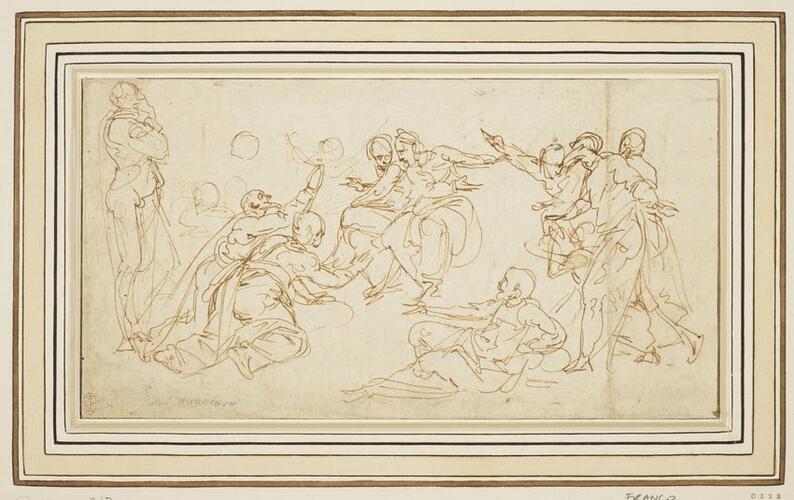-
1 of 253523 objects
The Ascension 1547
RCIN 990222

Battista Franco (c. 1510-1561)
The Ascension 1547
-
A pen and ink drawing of disciples at the Ascension of Christ, created as a preparatory study for a panel on the polyptych on the main altar of San Leopardo Catherdral, Osimo. Inscribed in a later hand along the lower edge: ‘Del Novelara’. Stamped in the lower left corner with an Edward VII blind stamp.
Though previously attributed to Lelio Orsi da Novellara, and then more widely to the school of Carracci, this drawing has since been recognized as by the Mannerist artist Battista Franco. Executed in fluid pen lines, the drawing depicts Christ’s disciples watching his ascension in wonder. Franco drew rapidly, indicating the heads of several figures with simple ovals and gesturing at their poses and drapery with abbreviated lines. This agile penmanship is characteristic of Franco’s drawings from the late 1540s and 50s.
The drawing is an exploratory study for a painted panel in the lower register of the fourteen panel polyptych created for the main altar of San Leopardo Cathedral, Osimo. The study is close to the finished panel, though Franco omits the more cursorily suggested figures in the upper left of the group. For a wider discussion of the commission and other associated preparatory drawings, see 'Battista Franco’s Osimo Polyptych and its Preparatory Drawings' Anne Varick Lauder and Hugo Chapman, (Artibus et Historiae, no. 74, XXXVII, 2016, pp. 43-58). The Royal Collection holds two further studies for the polyptych (RCIN 92220 and 990223).
Born in Venice, Franco moved to Rome in his twenties where he became heavily influenced by Michelangelo (1475 – 1564). According to the biographer Giorgio Vasari, engaging with drawing was central to the way in which Franco assimilated Michelangelo’s style, writing that for a while ‘Franco would do nothing but draw, and would not paint at all’ and that there was no ‘design, or sketch, nay not even a copy executed by Michelangelo’ that Franco did not copy (Vasari, Lives of the Most Eminent Painters, Sculptors, and Architects, Volume 5, p.33). Franco spent the majority of his career in Rome and Urbino, only returning to Venice in the last decade of his life.
-
Creator(s)